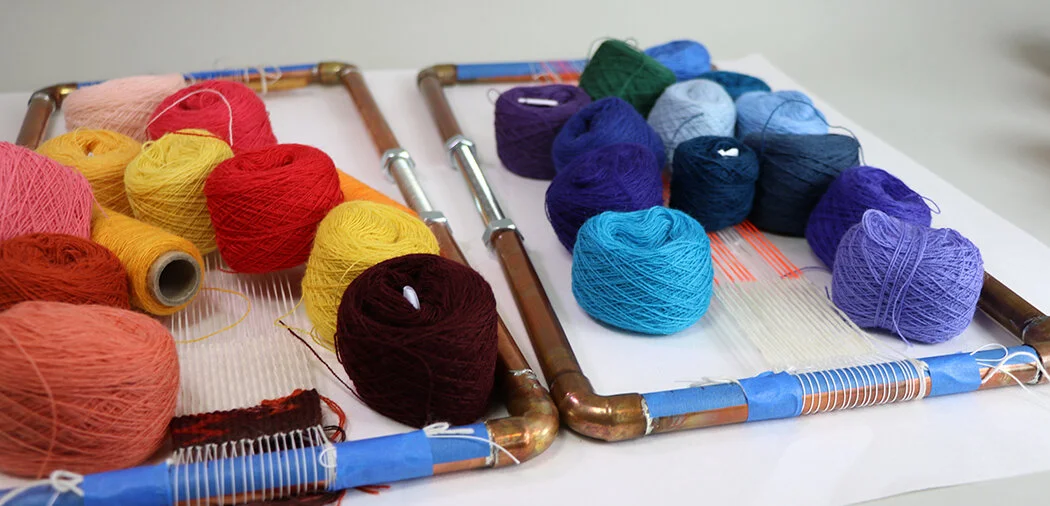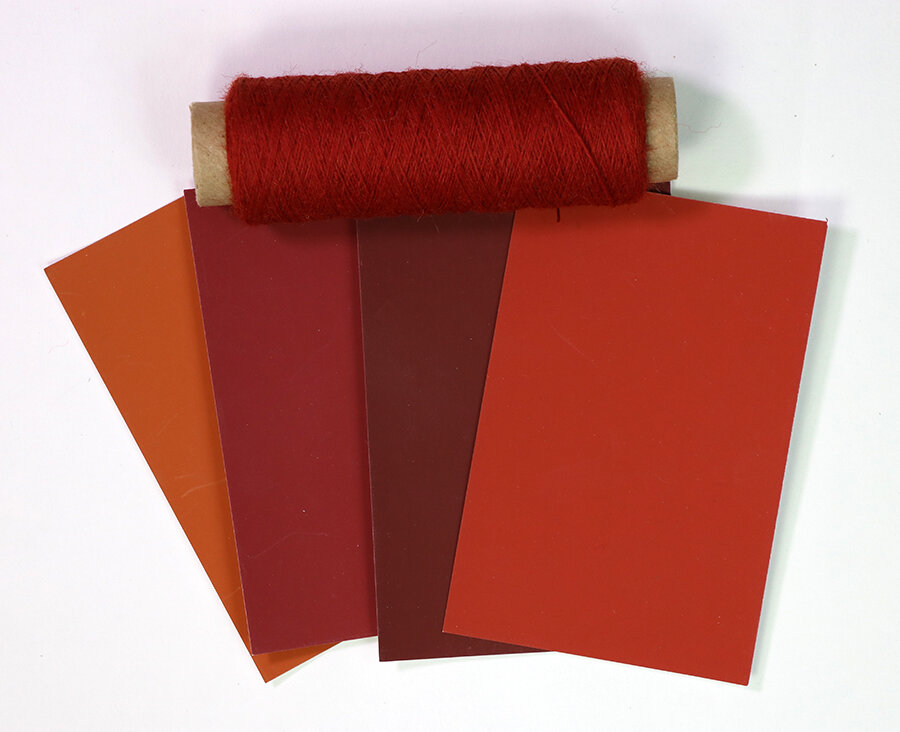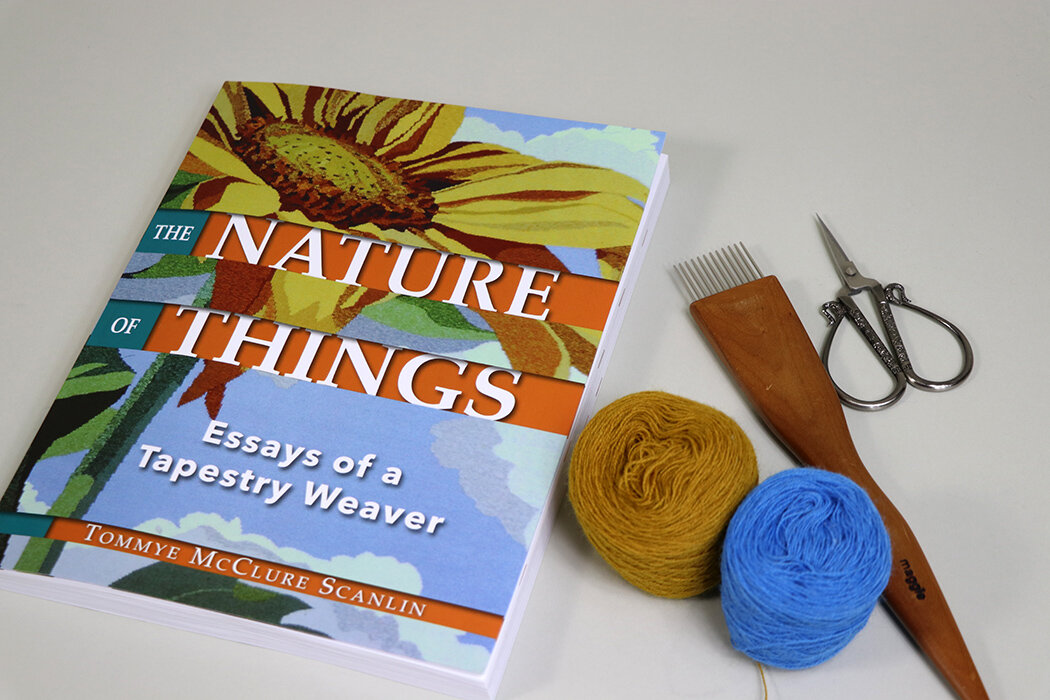Design Solutions for the Artist/Weaver, Season 2
Explore the beauty of turning your ideas into tapestry with Design Solutions for the Artist/Weaver Season 2.
This course is the second in the Design Solutions for the Artist/Weaver series of courses - all focused on helping turn your expressive ideas into designs you can weave.
Creating a tapestry design that is successful relies on many underlying skills.
Design Solutions for the Artist/Weaver, Season 2 specifically includes:
Color theory videos and exercises about cold/warm contrast, simultaneous contrast, and saturation.
Design videos and exercises about use of proportion, rhythm and repetition, shape and scale, and texture.
Content about creating backgrounds and mark-making in tapestry including interviews addressing these subjects.
Interviews with: Michael F. Rohde, Ayesha Barlas, Mary Lane, Micala Sidore, Tommye Scanlin, Jilly Edwards, and Molly Elkind.
Panel discussion with emerging tapestry artists about their learning paths and advice for working on tapestry design.
The first run of the course which started in January 2021 included live Q&A sessions. The recordings of these sessions are available for you to watch.
In all the Design Solutions for the Artist/Weaver courses, you will…
learn higher-level technical skills to increase weaving toolbox
delve into and discuss color theory
play with a variety of design techniques
explore the basic concepts of design
You’ll also hear from tapestry and fiber artists about their design practice and get their advice for working through design challenges.
All the materials are ready for you as soon as you sign up!
“I am totally impressed by the structure and content of the class. Often, in on-line courses, there is not enough thought given to the structural componenets of the course, but you nailed this. I felt very “safe” as within each module the objectives were clear and I knew what I was supposed to be working towards. I also liked all the references, the use of mixed media, the on-line discussions and comments from yourself and other students. The final element, being able to post after the course to receive critques and suggestions from you and others is very supportive and encouraging for tapestry weaving! ”
Pricing
The course costs $294.
WHAT IS INCLUDED IN THE COURSE?
My goal for you is to get solid information that you can utilize to design your own tapestries as well as tips and tricks to maintain your tapestry practice. This is a process. You learned tapestry techniques by practicing each of them until you understood how they work. The same thing is true for design (or any other new thing you’re learning). It will take practice to get better at these new skills, but this course will give you the support you need to commit to that work.
“I have really enjoyed the course. Surprisingly, for a course with focus on design, it has made me think more carefully about the technical aspects of tapestry weaving, and made me realise that a good design can be wasted if it is not beautifully executed, and that using the right materials and equipment contributes to a successful tapestry. This important lesson will hopefully allow me to improve my techniques and produce more consistent results in my weaving. Thank you Rebecca for a wonderful course.”
WHO IS THIS COURSE FOR?
This course is for anyone who struggles with tapestry design and wants to improve their skills in this area. Often it seems a fairly simple thing to learn the techniques. It just means weaving. But when faced with a blank warp, creating a successful design is another challenge we may not feel prepared to meet. Our journey to being intuitive designers of tapestries WILL take time and practice, so if you’re ready to improve your design skills in the field of tapestry, this course is for you.
Tapestry weaving is not always woven by the person who made the design. This course is for people who want to make their own designs and weave them. We call these people artist/weavers.
WHO IS THIS COURSE NOT FOR?
This course is not for people who are absolute beginners in the world of tapestry.You need to have a handle on the basic techniques and I recommend first taking Introduction to Tapestry here, or first part of Warp and Weft or the Little Looms course first.
It is also not for professional tapestry weavers. If you make a living in the field, sell your work, regularly win awards, or have solo shows, this course is not for you… though many of those people will be the voices we hear in the course!
What materials will I need for Design Solutions for the Artist/Weaver Season 2?
We will cover everything you need in the course, but here’s an overview:
First things first, I’m expecting you to have basic tapestry weaving tools that you like to use. To start with you’ll just need a tapestry loom (could be a small untensioned loom, something like a Mirrix, or a floor loom), some warp, and some yarn you like. As you start designing it is quite possible that you’ll have ideas for which you’ll want different yarns or tools, but you won’t know that until you get there.
Second, everyone will use a different set of materials for design. I teach exercises or that use materials you may or may not have at home. You do not need to purchase these things before the course starts unless you’re certain you’ll use them and you want to make sure you have them on hand.
Expand the boxes below for specifics:
-
• Adhesive (such as: double sided tape, clear tape, rubber cement, glue stick, scrapbooking double stick squares)
• Scissors for paper
• Ruler
• Pencil and eraser
• You will need a color wheel to refer to. This is the wheel I use in the course: https://woolery.com/color-wheel.html
• A lot of colored paper in different colors. I prefer Color Aid paper in 3 x 4.5 inch size with 314 colors: https://www.dickblick.com/products/color-aid-papers/ You can also use any number of different sorts of papers - such as paint swatches, construction paper, magazines, scrapbooking paper, etc. You just need a collection.
• (optional, though recommended) A notebook or journal to dedicate as your Color journal
-
• drawing pens (a fine Sharpie is enough or you can get some black Pigma Micron pens)
• colored pencils (this can be as simple kid friendly color pencils, but if you want to invest in high quality colored pencils - a small to medium set of Prismacolors is nice)
• sketchbook
• tracing paper
• plain copy paper
• window for lightbox (if you have a real one, great!)
• blue tape, masking tape, rubber cement, clear tape
• Color wheel. I prefer the 12-color color wheel of Johannes Itten but finding the Color Star tool for a reasonable price (about $40 USD) is almost impossible because it is long out of print.
• a camera or cell phone with black and white option (or free online software to convert from digital image)
• I will talk a bit about using computers for design. If you have an iPad or computer with a drawing program, that will come in handy. This particular video will not be helpful for people who don’t want to design on computers. But don’t buy any expensive equipment or programs until you see inside the course! Computer design may not be for you nor is it a required component of designing for tapestry.
-
• Paper punch: we will be cutting up lots of paper in this course, so a punch can be helpful for getting easily identical shapes. I like a 1 inch square punch.
• Paint: watercolor or acrylic
• Occasionally I mess with art journaling materials which can get pretty out of hand: acrylic paint, watercolors, brushes, paint trays, glues, various sorts of pens. The list could go on forever. I am unlikely to present a specific activity requiring these sorts of materials, but there may be activities you would want to extend to use with them.
We’ll practice color theory, design concepts in a hands-on way in this course.
FAQ
Why does this course have “seasons”?
Designing for tapestry or any kind of artwork is an ongoing practice. The subject matter is quite vast and it is my intention to provide ongoing support for your tapestry journey. This course is aimed at people who know the basic tapestry techniques but want some inspiration, instruction, and encouragement in the realm of designing for tapestry.
Each season of the course is sold separately. Find Design Solutions for the Artist/Weaver, Season 1 here.
How can we ask questions? Q&A details
In all my courses you can ask questions right in the platform. You can discuss with your fellow students and I do monitor questions and jump in from time to time with my thoughts.
There are also recordings of live Q&A calls available for you to watch. These live Q&A sessions were recorded in the January 2021 cohort.
Do I have to take Season 1 to participate in Season 2?
I do recommend starting with Season 1 because the information on color theory and design in this class builds on what came in that season. However, you are free to start with Season 2 if it somehow appeals to you. I won’t reteach things here that I cover in Season 1, so if you have extensive questions about things I presented in Season 1, I will refer you to that class.
Is there a time limit to the course?
No. You can start the course at any time and take as long as you want to to finish it. All the content is available for as long as you need it.
Are there subtitles in the videos?
All of the Design Solutions seasons have full subtitles and transcripts for all videos. These are available for people who are hard of hearing but also so that you can search the transcripts for information in your PDF reader and find information quickly. They can also be helpful if you didn’t understand something someone said.
Have more questions? There are FAQ pages HERE.
In the gallery below, click on the images to enlarge, hover for caption, arrows to scroll.


















